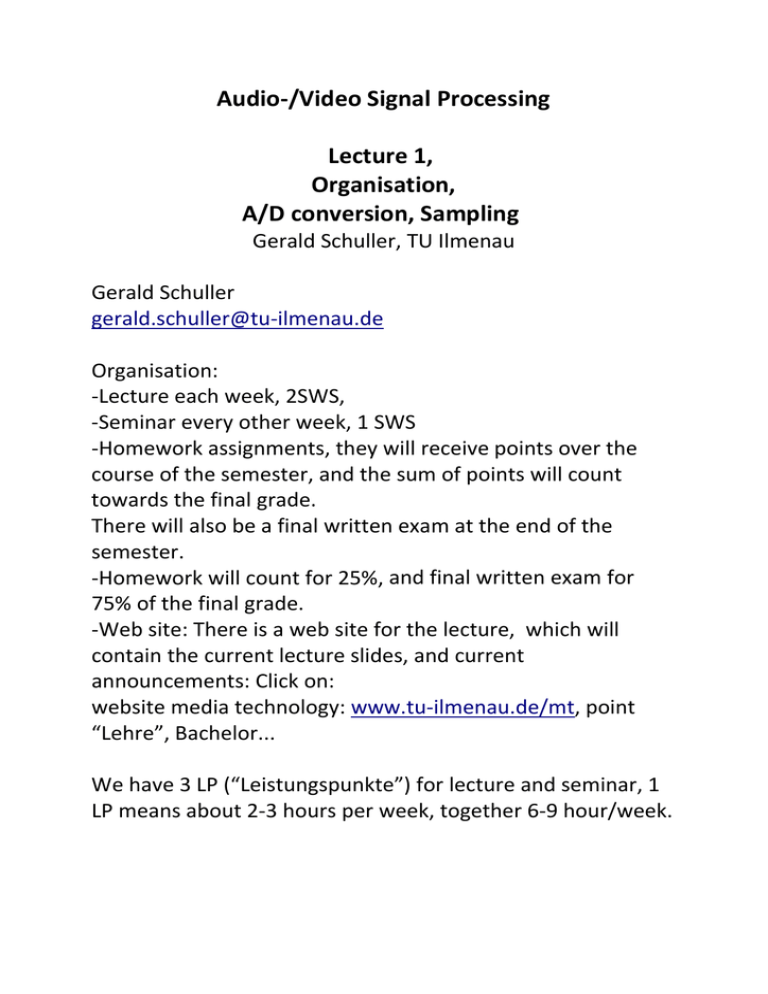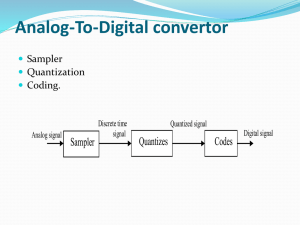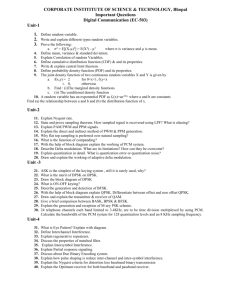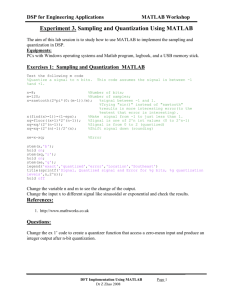E - TU Ilmenau
advertisement

Audio‐/Video Signal Processing Lecture 1, Organisation, A/D conversion, Sampling Gerald Schuller, TU Ilmenau Gerald Schuller gerald.schuller@tu‐ilmenau.de Organisation: ‐Lecture each week, 2SWS, ‐Seminar every other week, 1 SWS ‐Homework assignments, they will receive points over the course of the semester, and the sum of points will count towards the final grade. There will also be a final written exam at the end of the semester. ‐Homework will count for 25%, and final written exam for 75% of the final grade. ‐Web site: There is a web site for the lecture, which will contain the current lecture slides, and current announcements: Click on: website media technology: www.tu‐ilmenau.de/mt, point “Lehre”, Bachelor... We have 3 LP (“Leistungspunkte”) for lecture and seminar, 1 LP means about 2‐3 hours per week, together 6‐9 hour/week. Definitions: Audio‐/Video Signal Processing 2 Topics: Audio Signal Processing: Analog/Digital Conversation, Filter, to filter out frequencies, distortions (non‐linear processing), dynamic range compression (radio...), companding (compression/expansion), sound synthesis, sampling rate conversion Video Signal Processing: DSP (need for high throughput), image/video enhancements, denoising, conversions (pixel resolution, color), data compression, Together: Signal Processing, but each time a different signal type. Audio: usually lower data rate, higher sample resolution (16 bits/sample and up), 1‐dimensional Video: usually higher data rate, 2‐dimensional, lower sample resolution (typically 8 bit/pixel per component) We need to take into account the typical requirements of each signal type, for the different signal properties and also for the different receiver properties (human ear and eye). Application Example ITU G.711 speech coding. This is the first standard for ISDN speech coding, for speech transmission at 64 kb/s, with telephone speech quality. It uses a sampling rate of 8 kHz, and 8 bits/sample (hence we get 8*8=64 kbits/s). To obtain the 8 bits/sample, it uses companding, A‐law or mu‐law companding, to obtain 8 bits/sample from originally 16 bits/sample, with still acceptable speech quality. (ITU means International Telecommunications Unions, it standardizes speech communications) The procedure of G.711 can be seen as the following ‐Microphone input ‐Analog‐to‐Digital converter (A/D converter), including sampling at 8 kHz sampling rate. It usually generates 14‐16 bits/sample. Before the sampling there is an (analog) low pass filter with cut‐off frequency of 3.4 kHz. ‐Companding (compressing) with A‐Law or u‐Law, which generates 8 bits/sample from the original 16 bits/sample ‐Transmission to the receiver ‐Expanding the signal using the inverse A‐Law or u‐Law curve, to obtain the original 16 bits/sample ‐Digital to Analog conversion, including low pass filtering (about 3.4 kHz). This system allow us to have a telephone conversation over a digital ISDN line at 64 kb/s. This system was standardized in the 1970's, and at that time the hardware did not allow for much more than companding. Today we have much more powerful hardware (Moore's Law), and hence we can devise much more powerful compression algorithms. Today, at 64 kb/s, we can get very high quality speech, instead of just telephone quality speech. Current speech coders allow for audio bandwidths of above 10 kHz at that bit rate, which means speech sounds like if we are right there with the speaker. Also, at 64 kb/s, we can transmit high quality audio/music signals, using for instance, the MPEG‐AAC standard, which is also used in iTunes. This was actually the original motivation for the development of MPEG audio compression, to transmit high quality music over an ISDN line. ISDN lines are outdated nowadays, but compression remains useful, for instance for wireless connections (downloading or streaming to your wireless phone). Observe: ISDN has a fixed bit rate (64kb/s), and has a fixed connection. You dial to the person you would like to talk to, and have a fixed connection, and each bit you generate is send off to the receiver right away without delay. In contrast: The internet has no fixed bit rate, it depends on the individual connection, and there is also no fixed connection. There, first we assemble a certain number of bits into packets, these packets get headers with the receiver address, and then the switches in the internet rout the packet to the receiver. Observe that this also leads to delay, first for the assembling of the packet, and then for the switching in the internet. This also shows that originally, the internet was not made for real time communications, but just for data traffic. But the internet is becoming faster, with less delay, because it is constantly expanding, for higher bit rates. A/D and D/A Conversion of a signal Example: 4‐channel stereo multiplexed analog‐to‐digital converter WM8775SEDS made by Wolfson Microelectronics placed on an X-Fi Fatal1ty Pro sound card. From: Wikipedia, Analog-to-digital converter. This is on the sound card of your computer, where you connect your microphone and speakers to. A/D converter resolution: (From: Wikipedia, Analog‐to‐digital converter.) Observe: There is always a range of voltages which is mapped to the same codeword. We call this range Δ , or step size. These steps represent the quantization in the A/D process, and they lead to quantization errors. Output is a linear “Pulse Code Modulation” (PCM) signal. It is linear in the sense that the code values are proportional to the input signal values (we have a constant step size Δ). Quantization error for a full range signal: (From: Wikipedia, quantization error, the read line shows the quantized signal, the blue line in the above image is the original analog signal) Observe that the quantization error is simply an analog signal with values between −Δ /2 and + Δ/2 . The average quantization error power, or mathematically the Expectation of the quantization error power, is a positive number, which will give us some impression of the signal quality after quantization, if we set it in relation to the average or Expectation of the signal power. Then we get a Signal to Noise Ratio (SNR) for our quantizer and A/D converter. Our goal is to have a high Signal to Noise Ratio. How do we obtain a signal energy or power from a voltage (or alternative: current)? In signal processing we assume to have a load resistor of 1 Ohm. Using this we can compute a current from the voltage, and current times voltage is then the resulting power. Since we have 1 Ohm, and if the voltage is e, we get: power =voltage times current= e times e/1= e*e, and the result is simply squaring the voltage: power = e 2 . The expectation E(x) of a value x with probability density ∞ function p( x) (which has the property ∫ p( x)dx=1 ) −∞ is ∞ E ( x)= ∫ x⋅p( x)dx −∞ and the expectation of a function ∞ E ( f ( x)) is E ( x)=∫ f ( x)⋅p ( x ) dx −∞ This can also be interpreted as a weighted average, with the weights p( x) . See also: “Taschenbuch der Statistik”,Horst Rinne, Verlag Harry Deutsch, or Wikipedia: Erwartungswert. Hence for the average power or the expectation value of the power we obtain 2 E (e )= Δ/2 ∫ −Δ / 2 2 e ⋅p (e) where p(e) is the probability density function of our quantization error e . Assume the quantization error e is uniformly distributed, which is usually the case if the signal is much larger than the quantization step size Δ (large signal condition). Then all values of e are equally likely and we have p(e)=1/ Δ (such that the integral over all probabilities becomes 1, to make sure we have a probability distribution). This yields Δ/2 3 3 1 1 (Δ /2) (−Δ/2) Δ 2 2 E (e )= Δ ⋅ ∫ e de= Δ − = 3 3 12 e=−Δ / 2 2 2 Δ Hence the quantization error energy is: E (e )= 12 2 Mid‐rise and Mid‐tread quantization Depending on if the quantizer has the input voltage 0 at the center of a quantization interval or on the boundary of that interval, we call the quantizer a mid‐tread or a mid rise quantiser, as illustrated in the following picture: (From: http://eeweb.poly.edu/~yao/EE3414/quantization.pdf) Here, Q_i(f) is the index after quantization (which is then encoded and send to the receiver), which produces an index out of a voltage, and Q(f) is the inverse quantization, which produces the quantized reconstructed value at the receiver, it reproduces a voltage out of an index. This makes mainly a difference at very small input values. For the mid‐rise quantiser, very small values are always quantized to +/‐ half the quantization interval ( + /−Δ /2 ), whereas for the mid‐tread quantizer, very small input values are always rounded to zero. You can also think about the mid‐rise quantizer as not having a zero as a reconstruction value, but only very small positive and negative values. So the mid‐rise can be seen as more accurate, because it also reacts to very small input values, and the mid tread can be seen as saving bit‐rate because it always quantizes very small values to zero. Observe that the expectation of the quantization error power for large signals stays the same for both types (because of our assumption of signals much larger than the quantization step size Δ . The difference between the 2 only become apparent for very small signals. Example: Assume we have an 8 bit A/D converter, and a signal range of ‐1V to +1V. How big is our delta? Δ= 2V 1 V 8 = 2 128 Use this to compute the average quantization error power: 2 (1/128) −6 2 =5.086⋅10 V E (e )= Δ = 12 12 2 2 Compare this to the signal power if we have a full range signal, for instance uniformly distributed white noise, or a triangular or saw‐tooth wave, which have a uniform probability distribution for all possible signal values: Our signal is x, and it is between ‐1 and 1 V. Observe that this is again an analog signal, with a limited value range, just like the quantization error e. Now we just have a different value range. Instead of −Δ /2 to + Δ / 2 we have a range of values between ‐1 and +1. Hence we have the same type of problem as above, and can apply the same mathematical tools. Its average power is again the expectation value of x 2 over all possible values of x: 2 E ( x )= 1 ∫ x=−1 2 x ⋅p( x)dx Again we assume a uniform distribution for x over the interval from ‐1 to 1. We again need that the integral over the probability distribution is 1, or 1 ∫ x=−1 p( x) dx=1 For a constant p(x) This is true for p( x )=0.5 Companding Range of values is compressed, smaller values become larger, large values become smaller: (From: http://www.dspguide.com/ch22/5.htm) Sampling, Downsampling, Upsampling Sampling the analog signal, normalized frequency To see what happens when we sample a signal, lets start with the analog signal s(t). Sampling it means sample the signal at sample intervals T, or the sampling frequency f s . Mathematically, sampling can be formulated as multiplying the signal with a dirac impuls at the sampling time instances nT, where n is the number of our sample (n=0,… for causal systems). If the look at the Fourier transform of the analog system, we get ∞ S ( ω)= c ∫ s( t )⋅e− jωt dt t=−∞ where the superscript c denote the continuous version, with =2πf the angular frequency. If we now compute the Fourier Transform for the sampled signal, we get a sum, because the integral over a dirac impulse is just one, ∞ S ( ω)= ∑ s( nT )⋅e− jω nT d n=−∞ with the superscript d now denoting the discrete time version. Now we can see that the frequency variable only appears as ω nT , and T is the inverse of the sampling frequency. Hence we get T =/ f s=: This is now our normalized frequency, where 2 represents the sampling frequency and π is the so called Nyquist frequency (the upper limit of our usable frequency range). Observe that we use the capital to signify that this is the normalized frequency. The capitalized version is commonly used to distinguish it from the continuous, non‐normalized, version, if both are used. Otherwise, also the small is used in the literature, for the normalized frequency, if that is all we need, if there is no danger of confusion, as we did before. To indicate that we are now in the discrete domain, we rename our signal to x(n)=s(nT). Its spectrum or frequency response is then ∞ − jn ∑ X = x n e n=−∞ Because n is integer here (no longer real valued like t), we get a 2π periodicity for X . This is the first important property for discrete time signals. The above transform is called the Discrete Time Fourier transform (not the Discrete Fourier Fourier transform, which is for finite or periodic discrete time sequences. Here we still have an infinite “block length”). Also observe that for real valued signals, the spectrum of the negative frequencies is the conjugate complex of the positive frequencies, X −= X * where * denotes the conjugate complex operation, because − j − n − jn * . e = e Sampling a discrete time signal So what happens if we further downsample an already discrete signal x(n), to reduce its sampling rate? Downsampling by N means we only keep every Nth sample and discard every sample in between. This can also be seen as first multiplying the signal with a sequence of delta impulses (a 1 at each sample position), zeros in between, and later dropping the zeros. This multiplication with the delta train can now be used to mathematically analyse this downsampling, first still including the zeros. The frequency response now becomes d − j n X = ∞ = ∑ m=−∞ for all integers m. ∑ x ne n=mN x mN e− j mN






